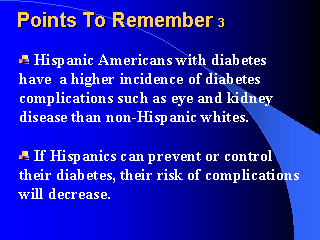|
|
|
|
front |1 |2 |3 |4 |5 |6 |7 |8 |9 |10 |11 |12 |13 |14 |15 |16 |17 |18 |19 |20 |21 |22 |23 |24 |25 |26 |27 |28 |29 |30 |31 |32 |33 |34 |review |
 |
The recognized major complications of diabetes are heart disease, stroke,
retinopathy, nephropathy, and neuropathy. The latter three can lead to
blindness, end-stage renal disease, and limb amputation, among others. Diabetes
mellitus is characterized by an absolute or relative insulin deficiency.
Research has shown that diabetes mellitus develops when failures in the process
of insulin production in pancreatic beta cells occur; when problems in insulin
cell-receptors arise; in the presence of hyperactive pituitary or adrenal
glands; or in the presence of liver malfunction, such as in cirrhosis of the
liver. The etiology, however, of diabetes mellitus is not yet fully understood.
The American Diabetes Association (ADA) has identified a number of screening factors to recognize individuals with high risk of developing Type 2 diabetes. Some of these risk factors as identified by the ADA are family history of Type 2 diabetes, body weight (20 percent above ideal weight), ethnicity, age (40 years old and older), and, in women, a history of gestational diabetes and/or having a baby weighing nine or more pounds at birth. Moreover, ADA statistics suggest that there is a higher prevalence of Type 2 diabetes among minority populations in the U.S. with 33 percent of Mexican-Americans 64 to 75 years of age that have Type 2 diabetes and 42 percent with undiagnosed diabetes. A interesting study assessed the impact of socioeconomic status on development of retinopathy and levels of hyperglycemia by comparing San Antonio Heart Study diabetics. The investigators found no association between socioeconomic status and Type 2 DM as measure by severe glycemia or retinopathy, suggesting a greater role of biological factors in the expression of severity of the disease in Mexican-Americans. Keep in mind that screening for eye disease and appropriate treatment can significantly reduce diabetes-related blindness. Screening and treatment is not only effective prevention, but is also cost-effective. Annual dilated eye exam:
|